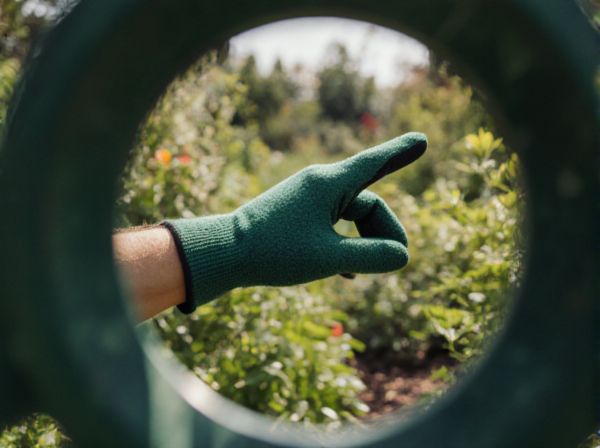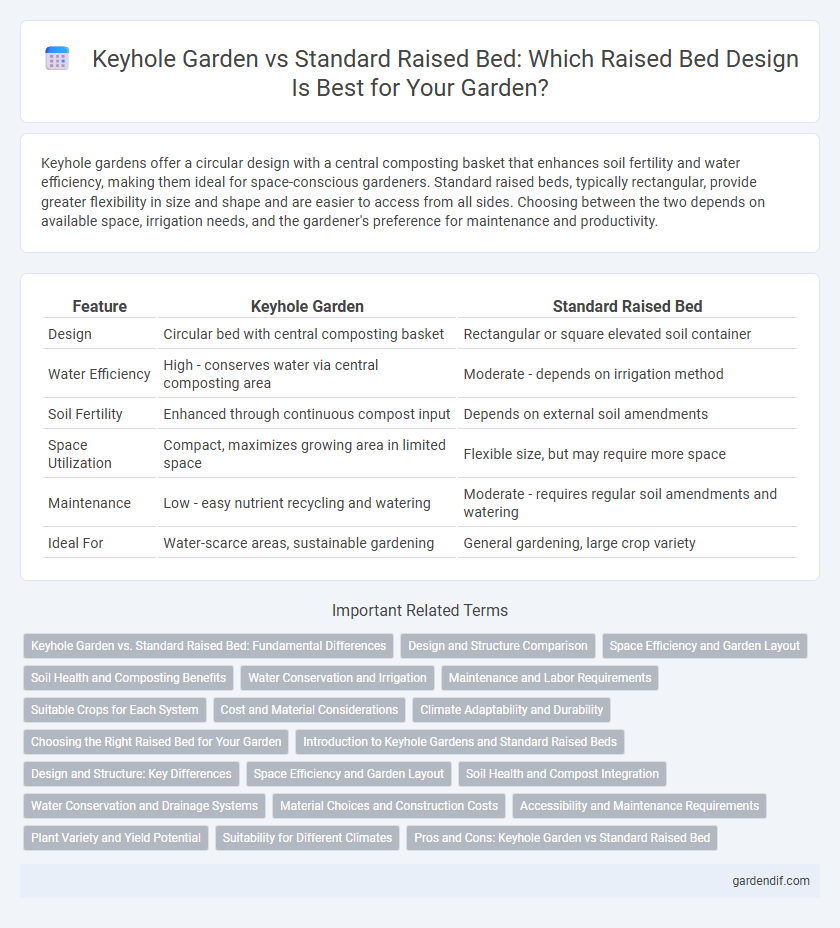
keyhole garden vs standard raised bed Illustration
Keyhole gardens offer a circular design with a central composting basket that enhances soil fertility and water efficiency, making them ideal for space-conscious gardeners. Standard raised beds, typically rectangular, provide greater flexibility in size and shape and are easier to access from all sides. Choosing between the two depends on available space, irrigation needs, and the gardener's preference for maintenance and productivity.
Table of Comparison
| Feature | Keyhole Garden | Standard Raised Bed |
|---|---|---|
| Design | Circular bed with central composting basket | Rectangular or square elevated soil container |
| Water Efficiency | High - conserves water via central composting area | Moderate - depends on irrigation method |
| Soil Fertility | Enhanced through continuous compost input | Depends on external soil amendments |
| Space Utilization | Compact, maximizes growing area in limited space | Flexible size, but may require more space |
| Maintenance | Low - easy nutrient recycling and watering | Moderate - requires regular soil amendments and watering |
| Ideal For | Water-scarce areas, sustainable gardening | General gardening, large crop variety |
Keyhole Garden vs. Standard Raised Bed: Fundamental Differences
Keyhole gardens feature a central composting basket that provides nutrients and moisture directly to plants, enhancing soil fertility and reducing water usage compared to standard raised beds. Their circular design with a keyhole-shaped opening allows easy access to all plants without compacting the soil, promoting better root growth and plant health. Standard raised beds typically lack internal composting systems and have rectangular shapes, which may require more water and effort to maintain soil nutrients consistently.
Design and Structure Comparison
Keyhole gardens feature a circular design with a central composting basket that enhances nutrient recycling and water efficiency, unlike standard raised beds which typically have rectangular shapes without integrated composting zones. The structure of keyhole gardens promotes superior soil aeration and root access due to its compact layout and inward-sloping edges, while standard raised beds offer more straightforward construction with easier scalability. This design difference impacts irrigation management, where keyhole gardens require less water and support higher yield per square foot compared to standard raised beds.
Space Efficiency and Garden Layout
Keyhole gardens optimize space efficiency by incorporating a central compost basket, allowing nutrients to recycle within a compact circular layout that maximizes planting area compared to standard rectangular raised beds. The circular design facilitates easier access to all parts of the garden without compacting the soil, enhancing plant growth and maintenance. Standard raised beds require more walking paths and space between beds, reducing overall planting density in limited garden areas.
Soil Health and Composting Benefits
Keyhole gardens enhance soil health by integrating a central composting basket that continuously recycles organic matter, enriching the soil with essential nutrients and promoting microbial activity. This sustainable composting system reduces the need for external fertilizers compared to standard raised beds, which rely more heavily on pre-mixed or periodically added soil amendments. The circular design of keyhole gardens also improves moisture retention and aeration, fostering a healthier root environment and more robust plant growth.
Water Conservation and Irrigation
Keyhole gardens maximize water conservation through their central composting basket that captures and recycles moisture, reducing irrigation needs compared to standard raised beds. The design promotes deep water penetration and minimal evaporation, making irrigation more efficient and less frequent. Standard raised beds typically require more frequent watering due to surface-level soil exposure and lack of integrated water retention features.
Maintenance and Labor Requirements
Keyhole gardens require less maintenance than standard raised beds due to their efficient water retention and central composting basket that reduces the need for frequent watering and fertilization. The design minimizes labor by simplifying composting and moisture management within a compact, easily accessible layout. Standard raised beds demand more ongoing labor for irrigation, soil amendments, and weed control, increasing overall maintenance efforts.
Suitable Crops for Each System
Keyhole gardens excel in growing a variety of leafy greens, herbs, and root vegetables due to their built-in composting system that provides continuous nutrient supply. Standard raised beds are versatile for growing larger crops such as tomatoes, peppers, and squash that require more space and consistent soil conditions. Choosing between these systems depends on crop type, space availability, and desired yield efficiency.
Cost and Material Considerations
Keyhole gardens typically require fewer materials due to their compact, circular design, lowering initial costs compared to standard raised beds that often use more lumber or stone for rectangular frames. The central composting basket in keyhole gardens reduces the need for excessive soil amendments, optimizing resource use and further cutting expenses. Standard raised beds may involve higher material and soil costs but offer easier scalability and design flexibility for larger gardening spaces.
Climate Adaptability and Durability
Keyhole gardens enhance climate adaptability by incorporating a central composting basket that improves water retention and nutrient cycling, making them ideal for drought-prone or arid regions. Standard raised beds offer durability with various materials like cedar or composite lumber that resist rot and weather damage, but may require more frequent watering in dry climates. Combining deep soil layers and mulching in both designs further boosts resilience against temperature fluctuations and moisture loss.
Choosing the Right Raised Bed for Your Garden
Keyhole gardens offer efficient water and nutrient management through a central composting basket, making them ideal for sustainable gardening in limited spaces. Standard raised beds provide versatile planting options with easier access and customizable sizes, suited for larger or traditional garden layouts. Choosing the right raised bed depends on your space, resource availability, and gardening goals, balancing water conservation with planting flexibility.
keyhole garden vs standard raised bed Infographic

 gardendif.com
gardendif.com